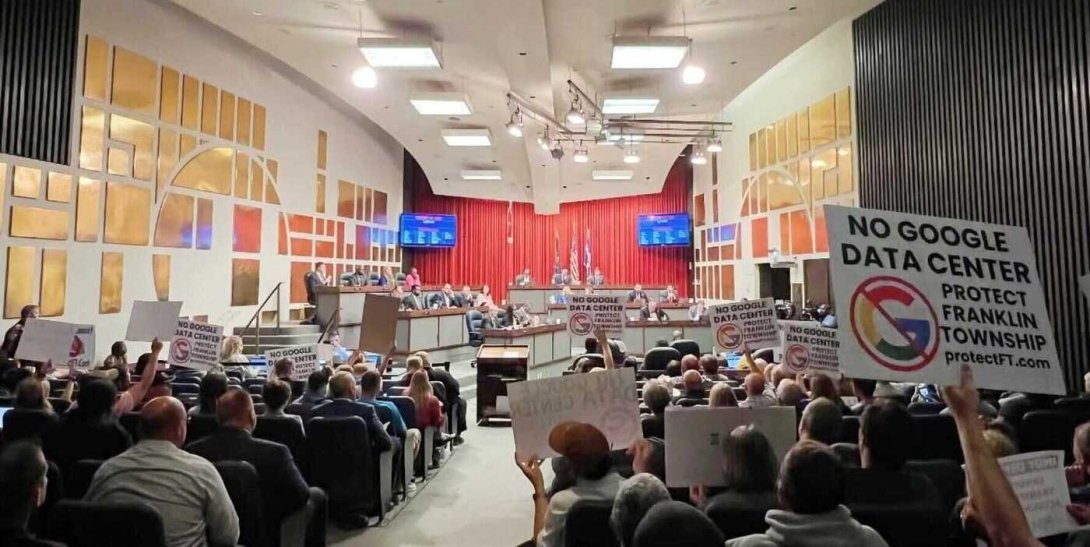Why Big Tech's Push for Data Centers Should Worry Us All

Google withdrew its proposal to build a hyperscale data center near Indianapolis after months of sustained community opposition.
Citizens Action Coalition Indiana’s Instagram page
As Climate Week was underway in New York City in September, Sam Altman was nearly 1,700 miles away in central Texas — and busy rapidly expanding his own climate footprint.
Since Sept. 22, OpenAI has doubled down on its leading role in Silicon Valley’s race to build out AI infrastructure — in particular, data centers. As communities ramp up resistance to new data-center construction everywhere from Alexandria, Virginia to Tucson, Arizona, major technology companies are charging ahead with their own dystopian plans.
Data centers consume substantial amounts of water and, as anthropologist Steven Gonzalez Monserrate writes, “collectively devour more energy than some nation-states.” At their largest, these industrial warehouses packed with computer servers — and the equipment needed to keep them cool — can span millions of square feet. Mark Zuckerberg has promised to build one the size of Manhattan.
According to CNBC, the plans OpenAI just announced would require an estimated “17 nuclear plants or about nine Hoover Dams” worth of energy. Even the editorial board of The Financial Times — not exactly a progressive publication — has called the immense environmental costs of AI infrastructure ironic “given tech companies’ image as shiny, clean replacements for old smokestack industries.”
There’s no irony — tech leaders have carefully curated and rhetorically reinforced their industry’s “shiny, clean” facade for decades. But the connections between companies like Amazon, Google and Microsoft and the “old smokestack industries” are everywhere you look. The construction and operation of data centers is made possible by some of the world’s most extractive and polluting industries — from open-pit mining to fossil-fueled power grids — and these relationships are symbiotic.
BP has a long-standing relationship with Amazon Web Services; ExxonMobil has oil-field operations powered by Microsoft’s cloud infrastructure. Dominion Energy — the largest utility in Virginia’s “Data Center Alley” and a company with a track record of violating state and federal environmental laws — is citing expected growth in data-center energy demands as a reason to construct new gas-powered plants and keep two coal-fired plants online.
Sacrifice zones
When it comes to data centers, frontline communities are finding themselves on well-trodden ground: with an industry treating them as sacrifice zones forced to pay the environmental and public-health costs of unchecked corporate profit-seeking.
From systematically obscuring the resource consumption and environmental impacts of these projects to exploiting communities’ needs for tax revenue, tech companies’ behaviors surrounding the construction and operation of data centers are squarely in line with fights communities have waged against “traditional” industrial infrastructures like power plants, factory-farming operations, and oil and gas pipelines.
Developers across the companies are using nondisclosure agreements (NDAs) with local officials to guard the details of their projects so closely that in many cases, the public doesn’t learn about a project until it’s on the brink of approval. Over the summer in Tucson, the details of a data-center facility were disclosed to the public only after developers had been in discussion with local officials — who were bound by an NDA — for over a year. Even then, it wasn’t clear who was behind the project until a local independent news outlet uncovered the secretive entity: Amazon Web Services.
As MediaJustice details in a September report on the expansion of data-center development in the U.S. South — where the environmental-justice movement began — these parallels are only becoming more stark: “While Big Tech boasts of the ‘magic’ and ‘super intelligence’ of AI, it is clear that they see poisoning Black communities and consuming billions of gallons of water in drought stricken states as collateral damage in their AI-driven wealth building.”
Journalists, step up
As more journalists and outlets take up this story — and we desperately need more reporters and newsrooms on the beat — keeping the bigger picture in frame becomes increasingly critical. It’s too easy to frame the rapid buildout of this infrastructure as an investment in our collective future. After all, a data center is making it possible for you to read this piece.
But this unprecedented explosion in data-center construction is an investment in one specific vision for the future — one that entrenches the power of dominant technology companies and enriches only those, like Sam Altman, who are at their helm.
Just as energy companies aren’t building multibillion-dollar oil and gas pipelines while imagining a world where fossil fuels will be regulated beyond profitability, tech companies aren’t investing billions in data centers while imagining a future where data-intensive surveillance technologies — including generative AI — are less ubiquitous or less profitable than they are today.
It’s a future where our communities’ resource needs take a back seat to the speculative pet projects of billionaires like Mark Zuckerberg — whose plans for a 4 million square-foot data-center campus in northeast Louisiana will require three new gas power plants to operate.
It’s a future tech companies are marketing as progress, even as these corporations cozy up to the Trump administration and other right-wing, authoritarian regimes around the world. It’s a future that we’re being told is inevitable.
But on Sept. 22, right before Altman announced OpenAI’s latest plans to massively scale up its planned AI infrastructure buildout, Google withdrew its proposal to build a hyperscale data center near Indianapolis after months of sustained community opposition.
Earlier in September, data-center development was put on hold in Prince George’s County, Maryland. So many residents showed up at the county’s data-center task-force meeting that even the overflow room was at capacity.
Silicon Valley may be racing ahead, but communities are catching up.
Help Free Press keep fighting for local communities: Donate today.